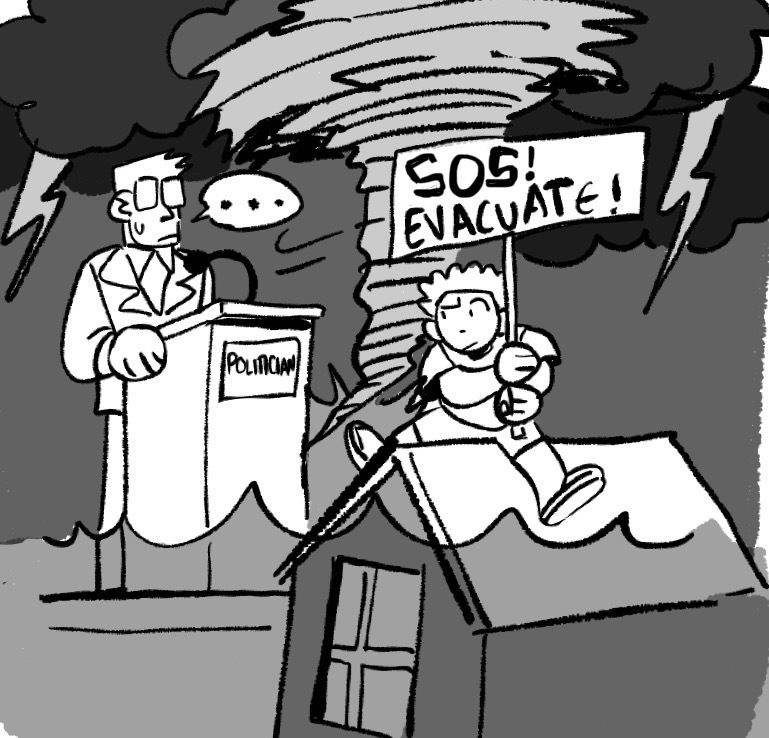In the aftermath of Hurricane Helene, President Biden’s visit to North Carolina came under fire for temporarily restricting the airspace and hindering relief efforts. At least, that’s what Elon Musk said and amplified on his platform, X.
The truth is that while there were airspace restrictions in place for Biden’s visit, the airspace was never shut down for relief or rescue aircraft. This misinformation spread so quickly in part due to a larger pattern of politicians visiting disaster zones and causing more problems than solutions. During the same media blitz, in the aftermath of Helene, former President Donald Trump also came under fire for having his aides arrange bricks from a damaged building for his press conference.
These two instances beg the question — what is the point of these visits? While some may argue that it is to reassure the residents of these disaster-stricken towns that their president, congressperson or governor is ensuring they receive all of the resources they need, this ignores the fact that politicians can easily connect with the same residents remotely.
I believe these press conferences are simply for the politicians to get a cheap photo op at the expense of rescue and rebuilding efforts. These events do not simply involve members of the press and the politician — they necessitate a team of security, staffers and local law enforcement who would likely be working on the cleanup otherwise. These photo ops also require a venue and an audience of locals for the politicians to listen to.
What is the point of this? Can the politicians not listen to people’s stories over the phone? Can they not make sure that local and national authorities have the funding they need to help with relief efforts from their desk in Washington where they sign the bills?
Or is it for the people? Do the American people need to see politicians handing out food and water to believe that their elected officials are helping with recovery efforts?
That last question may be part of the problem. People love to bring up the now-infamous clip of Trump throwing paper towels at a crowd following Hurricane Maria in 2017, but what few remember is that an investigation later found that the Trump administration blocked pre-approved funds from going to hurricane victims in Puerto Rico. But by diverting media attention to this photo op, he was able to get away with denying a relief package to the over 13,000 families who had their homes destroyed.
On the other hand, following Biden’s visit to Helene’s wreckage, the media has been largely focused on debunking misinformation around the airspace above North Carolina instead of the relief efforts which are going remarkably well due in part to Biden’s pre-approval of resources to be used by FEMA.
These conspiracies and distractions can have real world consequences. In North Carolina, there are people who have refused help from FEMA or even attacked aid workers due to this misinformation. While that is not all to blame on Joe Biden, by attaching his face to the recovery efforts through his visits, he has made the issue of residents accepting aid a political one.
But politicizing disaster relief did not start with Joe Biden. From Elon Musk’s baseless claims of airspace issues to Mike Johnson’s refusal to call the House to session to vote on further funding authorization, the right is squarely to blame for the confusion and distrust that has spread in the aftermath of Hurricanes Helene and Milton.
The conspirators said that the $750 payments to survivors was a loan — it wasn’t. They said FEMA funding had gone to or was used up by migrants on the southern board — it wasn’t. These theories have eroded trust that many people have for FEMA and other federal agencies, meaning that, as climate change causes more and more disasters, there will be fewer people receptive to pre-storm warnings and post-storm help.
When Donald Trump visited McClellan Park, California, in 2020 to meet with state officials after a wildfire destroyed many homes in the town, he said that the wildfires were largely the fault of poor forest management and were not the result of climate change. The use of this rhetoric by the president of the United States can and will result in people taking the threat of climate change less seriously and increase confusion in the immediate aftermath of a disaster like the 2020 wildfires.
This is no longer the 1960s. With communication technology available for government officials to talk to residents while coordinating with other officials, why increase the risk of a damaging mistake by visiting in person?
Alex Jurkuta writes about current events and politics. Email him at amj180@pitt.edu.


